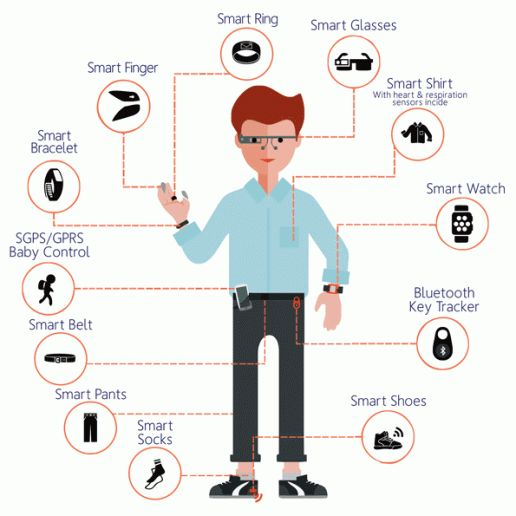
The Rise of Wearable Tech: How Smart Devices are Transforming Health and Fitness
Wearable Technology Health Tech Fitness Devices Smartwatches Digital Health Tech Trends Fitness Tracking IoT
The Rise of Wearable Tech: How Smart Devices are Transforming Health and Fitness
Wearable technology has evolved from basic fitness trackers to sophisticated smartwatches, health monitors, and even augmented reality devices. With advancements in sensors, AI, and connectivity, wearables are transforming the way we approach health, fitness, and overall well-being. In this post, we’ll explore the rise of wearable tech, its impact on personal health, and the future of smart devices in the health and fitness industry.
What is Wearable Technology?
Wearable technology refers to smart devices that are worn on the body, often integrating sensors, software, and connectivity to track various health and fitness metrics. From heart rate monitors and step counters to sleep trackers and ECGs, these devices are designed to provide real-time insights into your body’s performance, helping you stay healthy and active.
Some of the most popular types of wearables include fitness trackers, smartwatches, smart rings, and even smart clothing with embedded sensors. These devices can sync with your smartphone or other digital platforms to offer personalized health data and recommendations.
Top Innovations in Wearable Health Tech
As wearable technology continues to advance, the features and capabilities of these devices are expanding beyond simple step counting and calorie tracking. Here are some of the most significant innovations transforming wearable health tech:
1. Advanced Health Monitoring
Today’s smartwatches and fitness trackers offer a wide range of health monitoring features, including heart rate tracking, blood oxygen levels, and even electrocardiograms (ECGs). Devices like the Apple Watch and Fitbit Sense allow users to monitor potential heart conditions, track their blood oxygen saturation, and receive alerts for abnormal health metrics. These features make it easier for users to stay on top of their health and catch early warning signs of potential issues.
2. Sleep Tracking and Analysis
Wearable devices are becoming more sophisticated in tracking sleep patterns, analyzing your sleep stages (light, deep, REM), and providing insights to improve sleep quality. Some wearables also offer suggestions on how to create better sleep habits by monitoring factors such as your heart rate variability and breathing during the night. Improving sleep is essential for overall health, and wearables are making it easier to understand and optimize your rest.
3. Fitness and Activity Tracking
Fitness trackers and smartwatches are known for their ability to monitor physical activity, such as steps taken, calories burned, and exercise intensity. However, modern wearables are now capable of tracking a wide range of workouts, from running and cycling to yoga and strength training. Many devices offer personalized coaching, suggesting tailored workout plans and tracking performance in real-time to help users achieve their fitness goals.
4. Integration with AI and Machine Learning
Many wearable devices are integrating AI and machine learning to provide more personalized health recommendations. By analyzing data from multiple sensors over time, these devices can learn your habits, predict your fitness trends, and offer advice on how to improve your health based on real data. This makes wearable tech not only a tool for tracking but also a coach that helps guide you towards healthier behaviors.
How Wearable Tech is Revolutionizing Health and Fitness
The rise of wearable technology is changing the way we manage our health and fitness, offering several key benefits:
1. Real-Time Health Insights
Wearables provide real-time data on a range of health metrics, from heart rate and activity levels to sleep and stress management. This constant stream of information empowers users to make informed decisions about their lifestyle, helping them stay healthier and more active on a daily basis.
2. Increased Motivation and Accountability
Many wearables offer goal-setting features, badges, and progress tracking that motivate users to stay active. Whether you’re aiming to hit 10,000 steps a day or training for a marathon, these devices provide feedback and encouragement that keep you accountable and motivated.
3. Better Management of Chronic Conditions
For individuals managing chronic health conditions, wearables provide an easy way to monitor important health data. For example, diabetics can use smart devices to monitor blood sugar levels, while individuals with heart conditions can keep an eye on their heart rate or receive alerts if irregularities are detected. This makes it easier for people to manage their conditions and work with healthcare providers to stay on top of their health.
4. Personalization and Data-Driven Recommendations
With the integration of AI, wearables can offer more personalized health recommendations based on your specific habits, goals, and body metrics. For example, a wearable might suggest specific workout routines, recovery strategies, or dietary changes based on your performance data and overall goals.
The Future of Wearable Technology
The future of wearable technology is full of exciting possibilities. As sensor technology continues to evolve, we can expect even more accurate and detailed health tracking. Additionally, wearable devices are likely to become more integrated with other technologies, such as augmented reality (AR) and virtual reality (VR), creating more immersive fitness and health experiences.
In the healthcare industry, wearables may soon play a larger role in remote patient monitoring and telemedicine, allowing doctors to track patient health remotely in real-time. This could transform how healthcare is delivered, making it easier to manage conditions and provide preventative care without needing to visit a clinic.
Conclusion
Wearable technology is rapidly changing how we approach health and fitness. From advanced health monitoring to personalized workout plans, these devices are providing users with the tools they need to live healthier and more active lives. As innovation in this space continues, wearables are set to play an even bigger role in how we manage our health, making it easier than ever to stay fit, track important health metrics, and reach personal wellness goals.
Thank you for reading, and stay tuned for more insights and tips as we continue our tech journey together!